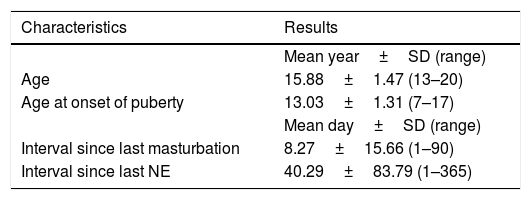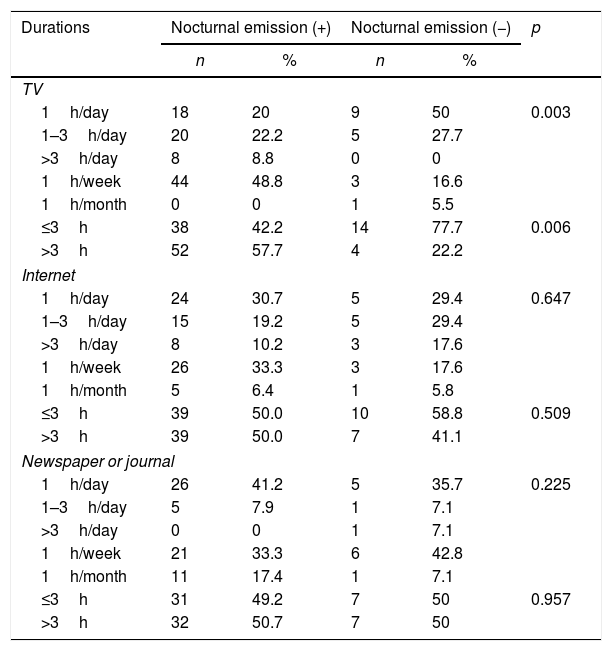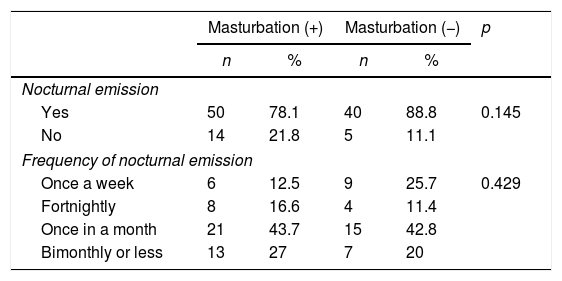Although nocturnal emission (NE) is an integral part of normal sexual function of males, little information has been documented in the literature. We aimed to assess masturbation habits and frequency of NE among virgin male religious Muslim teenagers.
Materials and methodsA questionnaire was administered to students staying in a religious dormitory or attending a religion course. Data of 113 male-respondents including demographic characteristics, masturbation habits and frequency of NE were collected.
ResultsThe mean age of students was 15.88±1.47 (range: 13–20) years. Of the students, 46(41.4%) reported that they never masturbated and 19 (17.3%) never experienced NEs. NE frequency was not correlated with age (p=0.092). Having NEs was not related to the time since last masturbation either (p=0.479). Subjects watching TV more than 3h/day had more NEs than the ones watching less (p=0.006). Of the subjects 13.6%, 12.6% and 67% believed that masturbation is halal, permissible and forbidden by religion, respectively whereas these rates were 59.1%, 20.4% and 7.5% for NE.
ConclusionsAlthough masturbation and NE are frequent among virgin male religious Muslim teenagers, a significant proportion of young men believe that only masturbation, but not NE, is forbidden by religion. Watching TV seems to be associated with the frequency of NEs. Further studies are required to elicit the factors affecting frequency of NEs.
Aunque la emisión nocturna (EN) es una parte integral de la función sexual normal de los varones, hay poca información documentada en la bibliografía. Nuestro objetivo es evaluar los hábitos de masturbación y la frecuencia de las EN entre los adolescentes musulmanes vírgenes y religiosos.
Materiales y métodosSe facilitó un cuestionario a estudiantes de una residencia religiosa o que asistían a un curso de religión. Se recogieron datos de 113 varones encuestados, incluidas las características demográficas, los hábitos de masturbación y la frecuencia de EN.
ResultadosLa media de edad de los estudiantes fue de 15,88±1,47 (rango: 13-20) años. Cuarenta y seis estudiantes (41,4%) afirmaron que nunca se habían masturbado y 19 (17,3%) nunca habían experimentado una EN. La frecuencia de EN no se correlacionó con la edad (p=0,092). Tener EN tampoco estaba relacionado con el tiempo transcurrido desde la última masturbación (p=0,479). Los individuos que veían la televisión más de 3h al día presentaban mayor tasa de EN, que los que la veían menos de 3h (p=0,006). De los individuos encuestados, el 13,6, el 12,6 y el 67% creían que la masturbación es halal, aceptable y prohibida por la religión, respectivamente, mientras que estas tasas fueron del 59,1, del 20,4 y del 7,5% para la EN.
ConclusionesAunque la masturbación y las EN son frecuentes entre los adolescentes musulmanes vírgenes y religiosos, una proporción considerables de ellos cree que la religión prohíbe la masturbación, pero no la EN. Parece que ver la televisión está asociado con la frecuencia de las EN. Se requieren más estudios para obtener los factores que afectan a la frecuencia de las EN.
Ejaculatory response is the biological and psychological end point of sexual stimulation and despite many investigations its physiology has not been still clearly understood.1 Ejaculation can be divided into three phases: emission, ejection (or penile expulsion) and orgasm.1 Emission consists of contractions of seminal vesicles and the prostate, with expulsion of sperm and seminal fluid into the posterior urethra while ejection involves pulsatile contractions of the bulbocavernosus and pelvic floor muscles together with relaxation of the external urinary sphincter and the closure of bladder neck.1 Orgasm, the final phase of the ejaculatory response, is the result of cerebral processing of pudendal nerve sensory stimuli.2,3
Nocturnal emission (NE) is a spontaneous orgasm and can be defined as ejaculation during sleep.4 NE is mainly considered as an autonomous reflex mediated by sympathetic nervous system.4 Although NE is an integral part of normal sexual function of males, little information has been documented in the literature and most of our knowledge come from the study of Kinsey published in 1948.5
Masturbation is sexual self-stimulation of genitalia for orgasm by usually using one's own hands. It is a sin in view of Islam since Quran implies (23: 5–7) and Imam Ja’far as-Sadiq explained so.6 To our knowledge, there are not any studies, which evaluated the beliefs of religious Muslim teenagers regarding masturbation and NE in the 21st century, when modern world media is more influential than Quran and Hadiths among teenagers. Moreover, the association between NE and masturbation frequency has never been analyzed in a scientifically sound study.
Therefore, the aim of this study was to evaluate the frequency of NE among virgin male religious Muslim adolescents and determine its correlation with the masturbation habits and/or some relevant factors. Moreover, the beliefs of the religious adolescents regarding masturbation and NE were also recorded.
Material and methodsStudy designWe conducted an epidemiological study according to the classification categorized in study of Rio et al.7 A 24-item non-validated questionnaire (supplementary data) was designed specifically to investigate the frequency of NE and masturbation habits among virgin male Muslim teenagers along with some potential factors that might have an impact on them. The questionnaire also included two questions related to Islamic perspectives of the subjects regarding both NE and masturbation. One of the investigators (AG) explained all the questions in detail before administering the questionnaire to the subjects. The participants responded to the questions whichever they wanted without stating name and gave them back in an envelope. The study was approved by the institutional review board and respondents provided their informed consent along with their parents.
Study sampleThe study sample consisted of students staying in a religious dormitory or attending to an Islamic course between January and May 2014. A total of seven dormitories/courses were invited and three of them refused to be included in this study. The questionnaire was distributed to 150 subjects and 119 (79.33%) of them brought back the data collection forms. After exclusion of 6 subjects having a history of sexual intercourse with a female partner, 113 (75.33%) subjects between ages 13 and 20 years were included into the study.
Statistical analysisStatistical analyses were performed using Number Cruncher Statistical System 2007 statistical software package program (NCSS, LLC, Utah, USA). Kolmogorov–Smirnov test was used to assess whether the distribution of the data is normal. In addition to descriptive statistics (mean, standard deviation), Tukey's range test for subgroup comparison of one-way variance analysis and independent t test for comparison of paired groups were applied. Moreover, qualitative data were compared using chi-square. Statistical significance was set as p<0.05.
ResultsThe baseline characteristics of the students included in study are shown in Table 1. Mean age at onset of puberty was recorded based on the self-reported history. Of the students, 46 (41.4%) recorded that they never masturbated whereas 19 (17.3%) indicated that they never experienced NE. None of them recorded experience of oral sex.
Baseline characteristics of the study sample.
| Characteristics | Results |
|---|---|
| Mean year±SD (range) | |
| Age | 15.88±1.47 (13–20) |
| Age at onset of puberty | 13.03±1.31 (7–17) |
| Mean day±SD (range) | |
| Interval since last masturbation | 8.27±15.66 (1–90) |
| Interval since last NE | 40.29±83.79 (1–365) |
| Mean year±SD (n) | |
|---|---|
| Frequency of NE | |
| Every day | 0 |
| Every other day | 0 |
| Once a week | 18.29±4.55 (17) |
| Fortnightly | 15.57±1.39 (7) |
| Once in a month | 17.78±3.75 (23) |
| Bimonthly or less | 19.90±4.55 (21) |
| Frequency of masturbation | |
| Every day | 14.92±0.79 (12) |
| Every other day | 14.33±0.52 (6) |
| Once a week | 15.73±0.94 (22) |
| Fortnightly | 15.60±1.82 (5) |
| Once in a month or less | 16.22±1.59 (18) |
Although 91 subjects reported that they had NEs, 65 (71.4%) subjects answered the question related to the time of last NE and the mean interval since the last NE. NE frequency was not correlated with age (p=0.092). Effect of time spent on TV, Internet and newspaper or journals on NE is demonstrated in Table 2. Subjects watching TV more than 3h/day had more NEs than the ones watching less (p=0.006). Moreover, the association between NE and habits of masturbation is shown in Table 3.
The relationships between NE and time spent on TV, Internet, newspaper or journals among the subjects.
| Durations | Nocturnal emission (+) | Nocturnal emission (−) | p | ||
|---|---|---|---|---|---|
| n | % | n | % | ||
| TV | |||||
| 1h/day | 18 | 20 | 9 | 50 | 0.003 |
| 1–3h/day | 20 | 22.2 | 5 | 27.7 | |
| >3h/day | 8 | 8.8 | 0 | 0 | |
| 1h/week | 44 | 48.8 | 3 | 16.6 | |
| 1h/month | 0 | 0 | 1 | 5.5 | |
| ≤3h | 38 | 42.2 | 14 | 77.7 | 0.006 |
| >3h | 52 | 57.7 | 4 | 22.2 | |
| Internet | |||||
| 1h/day | 24 | 30.7 | 5 | 29.4 | 0.647 |
| 1–3h/day | 15 | 19.2 | 5 | 29.4 | |
| >3h/day | 8 | 10.2 | 3 | 17.6 | |
| 1h/week | 26 | 33.3 | 3 | 17.6 | |
| 1h/month | 5 | 6.4 | 1 | 5.8 | |
| ≤3h | 39 | 50.0 | 10 | 58.8 | 0.509 |
| >3h | 39 | 50.0 | 7 | 41.1 | |
| Newspaper or journal | |||||
| 1h/day | 26 | 41.2 | 5 | 35.7 | 0.225 |
| 1–3h/day | 5 | 7.9 | 1 | 7.1 | |
| >3h/day | 0 | 0 | 1 | 7.1 | |
| 1h/week | 21 | 33.3 | 6 | 42.8 | |
| 1h/month | 11 | 17.4 | 1 | 7.1 | |
| ≤3h | 31 | 49.2 | 7 | 50 | 0.957 |
| >3h | 32 | 50.7 | 7 | 50 | |
Association between NE and masturbation habits.
| Masturbation (+) | Masturbation (−) | p | |||
|---|---|---|---|---|---|
| n | % | n | % | ||
| Nocturnal emission | |||||
| Yes | 50 | 78.1 | 40 | 88.8 | 0.145 |
| No | 14 | 21.8 | 5 | 11.1 | |
| Frequency of nocturnal emission | |||||
| Once a week | 6 | 12.5 | 9 | 25.7 | 0.429 |
| Fortnightly | 8 | 16.6 | 4 | 11.4 | |
| Once in a month | 21 | 43.7 | 15 | 42.8 | |
| Bimonthly or less | 13 | 27 | 7 | 20 | |
Of the subjects recruited, 65 (57.5%) with a mean age of 15.68±1.42 years reported that they masturbate routinely. Having NE was not related to the masturbation (p=0.145) or time since the last masturbation (p=0.479).
Religious perspectives of the subjects regarding both NE and masturbation were also analyzed. Of the entire study population 13.6%, 12.6% and 67% believed that masturbation is halal, permissible and forbidden by religion, respectively whereas these rates were 59.1%, 20.4% and 7.5% for NE.
DiscussionAlthough NE is one of the most prevalent sexual behaviors and is a significant feature of sexuality for males, little is known about it.5 Debate on the theological aspect of NE goes back to Middle Ages.8 Christian monks believed that NE is a temptation, until St Augustine stated the opposite.9 However, NE was again considered a sin later during the 16th and 17th centuries and even penis rings with sharp spikes were designed to prevent spontaneous erections in this era.10 Kinsey accepted NE as the one form of sexual outlet for which the individual is least responsible and recorded similar frequencies of NE between the active and inactive members of religious groups.5 He claimed that, although some individuals reported some feelings of lassitude after experiencing a NE, most of the boys accepted it as a normal part of male experience. In our study, only 7.5% of the volunteers reported that they think NE is forbidden by religion.
Of the samples in our study, 17.3% had never experience of NE, which is similar to the previous publications.5,11 It has been demonstrated that the frequency of NE may differ considerably between different social levels, with being the highest incidence among those males who go to college.5 In order to eliminate the impact of different social levels and/or educational level, we chose a homogeneous sample of teenagers from the same region of the city, with same cultural background and life styles.
A survey conducted in Indonesia revealed that only 1% of men had their first NE episode before the age of 12 years, whereas by the age of 15, almost half (47%) of men had their first wet dream and by age 17, 77% had wet dreams.11 However, unfamiliarity with the term, confusion, negative reception of NE may also result in low response rates to the questions regarding the onset of NE.4,12
The association between masturbation and NE has been investigated for many years.13–15 In 1988, Burg published the sexual logbook of a United States marine who recorded his sexual activity from 1852 to 1858.16 By tracking his data on masturbation, NE and sexual intercourse; the marine hoped to control and ultimately eliminate the occurrence of involuntary orgasms. The marine ended his record keeping at age 25 and Burg could not demonstrate a correlation between masturbation and NE frequencies when he applied modern statistical techniques on the data. In 1948, Kinsey also showed that there is little or no relationship between rates of masturbation and frequency of NE although the individuals in his study credited the frequent NE to the fact that they did not masturbate.5 In accordance with the findings of the aforementioned studies, we could not detect any association between masturbation and NE frequencies.
An anonymous article published in the beginning of the 20th century presented the history of a healthy, unmarried, chaste man who kept a record of his NE episodes between the ages 30–38.17 His NE episodes ranged from 0 to 9 per month, with a median monthly emission frequency of 3. He argued that his NE exhibited a seasonal variation with a spring and summer rise.17 However, 110 years after this report, Widaman and Helm reanalyzed the data presented in this anonymous article by using the current state-of-the-art statistical methods to reassess the association of NE with seasonal changes and could not identify any dependence as a function of month or season.18 They revealed a waning of NE frequency with age. Similarly, Kinsey demonstrated that NE was primarily an outlet of younger adolescents and older teenage boys.5 Although NE was still reported in males over age of 60s, the overall frequency was the highest between adolescence and 30 years of age and dramatically decreased after this age span. However, we could not find an association between age and frequencies of NE either. This may be partially explained with a limited age range of our study (13–20 years).
Another finding of the Indonesian survey is that the mean age of the first NE is decreasing.11 It can be speculated that in addition to the global earlier onset of puberty, easier accessibility of visual erotic material including television, magazines and the Internet might be responsible for this early onset of NE.19 Also, sexual fantasies and cognitions may increase in relation with these visual sexual stimuli and they affect the sexual behaviors and health.20 Our results showed that subjects watching the TV more than 3h a day reported more frequent NEs. However, having an Internet access or the time spent on Internet did not increase the frequency of NE.
This study is not without limitations. First of all, the sensitive nature of the conditions questioned may result in systematic biases, as the religious teenagers may be embarrassed to report their masturbation habits and/or their NE episodes. Comparing the data of these teenagers with a non-religious, age-matched study population would be of interest. Moreover, the questionnaire used for data collection is not validated prior to the study and this may result in response bias. Additionally, we could not determine the age of the first NE episode because of the recall difficulties. Finally, our study sample was relatively homogenous in terms of age, sociocultural level, educational status and sexual experience; therefore our findings may not represent the actual male population. However, we believe that the results of this study will contribute to our knowledge related to NE, which is a neglected phenomenon in the field of sexual medicine.
In conclusion, masturbation and NE are frequent among virgin male religious Muslim teenagers and a significant amount of them believe that masturbation, but not NE, is forbidden by religion. Watching TV seems to be associated with the frequency of NEs. Further studies with larger population are needed to confirm this association and to find out other factors which may have an impact on the frequency of NE.
FundingThis research did not receive any specific grant from funding agencies in the public, commercial, or not-for-profit sectors.
Conflict of interestsThe authors declare no conflict of interests.
Ethical disclosuresProtection of human and animal subjectsThe authors declare that the procedures followed were in accordance with the regulations of the relevant clinical research ethics committee and with those of the Code of Ethics of the World Medical Association (Declaration of Helsinki).
Confidentiality of dataThe authors declare that they have followed the protocols of their work center on the publication of patient data.
Right to privacy and informed consentThe authors have obtained the written informed consent of the patients or subjects mentioned in the article. The corresponding author is in possession of this document.
The authors would like to thank to Stanley E. Althof, PhD for his valuable contributions to the study.






